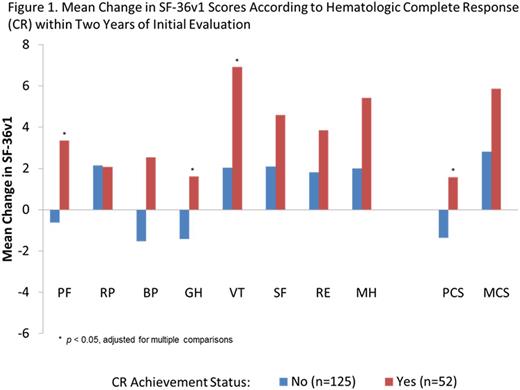Abstract
Introduction:Previous research has reported broad deficits in health-related quality of life (HRQoL) in patients with immunoglobulin light chain (AL) amyloidosis. While research also shows improvements in HRQoL following treatment with high-dose melphalan and stem cell transplantation (SCT), little is known about whether changes in HRQoL corresponding to a hematologic complete response (CR) are indicative of clinically meaningful changes in functioning and well-being. The purpose of this analysis is to examine patterns of change in HRQoL among AL amyloidosis patients by achievement of hematologic CR following targeted treatment of plasma cell dyscrasia.
Methods: Patients with AL amyloidosis were asked to complete the SF-36v1 Health Survey (SF-36v1) during clinic visits at the Amyloidosis Center at Boston University between 1994 and 2014. A complete case analytic sample (n=177) was created based on the following eligibility criteria: 1) patients with an SF-36v1 observation within 30 days of their initial evaluation at the clinic; and 2) patients with an SF-36v1 observation within two years of their initial evaluation that also corresponded to a visit with a recorded CR status. The SF-36v1 assessed HRQoL across eight domains and two component summary measures: physical functioning (PF); role limitations due to physical health problems (RP); bodily pain (BP); general health (GH); vitality (VT); social functioning (SF); role limitations due to emotional health problems (RE); mental health (MH) and physical (PCS) and mental (MCS) component summaries. Higher SF-36v1 scores represented better functioning. Baseline characteristics of patients were compared by CR status using two-sample t-tests and chi-square tests for continuous and categorical variables, respectively. Paired t-tests were conducted to test for significant differences between baseline and follow-up SF-36v1 scores within each CR status group. Changes in SF-36v1 scores were compared to established minimal important changes (MICs) to determine whether the observed changes may be clinically meaningful to patients and clinicians. Finally, changes in SF-36v1 scores in relation to CR status were examined using generalized linear models controlling for CR status, baseline scores, and potential confounders.
Results:Significant improvements in VT, MH, and MCS scores were observed among patients with CR within two years of their initial evaluation (adjusted p < 0.05 for all). The mean changes in VT and MCS among patients with CR also exceeded established MICs. Among patients without CR, significant improvements were observed for RP, VT, MH, and MCS; however these significant changes did not persist after adjusting for multiple comparisons. Significant associations between CR status and changes in SF-36v1 were observed for PF, GH, VT, and PCS (adjusted p <0.05 for all). For each of these scales, with the exception of VT, the mean scores increased among patients with CR and declined among patients without CR.
Conclusion: Meaningful change in HRQoL was observed among AL amyloidosis patients with hematologic CR following treatment directed against plasma cell dyscrasia, specifically for aspects of mental well-being. Furthermore, changes in HRQoL differed significantly by CR status for several aspects of physical health. While previous studies in AL amyloidosis have highlighted significant deficits, particularly in physical health, these findings stress the importance of considering multi-dimensional aspects of HRQoL in this condition. While treatments may ultimately focus on improving physical functioning, achieving CR may have important changes to patients' mental health.
McCausland:Prothena Biosciences Inc: Research Funding. White:Prothena Biosciences Inc: Research Funding. Bayliss:Prothena Biosciences Inc: Research Funding. Guthrie:Prothena: Employment, Equity Ownership, Other: Leadership. Oliver:Prothena Biosciences, Inc.: Employment, Equity Ownership.
Author notes
Asterisk with author names denotes non-ASH members.


This feature is available to Subscribers Only
Sign In or Create an Account Close Modal